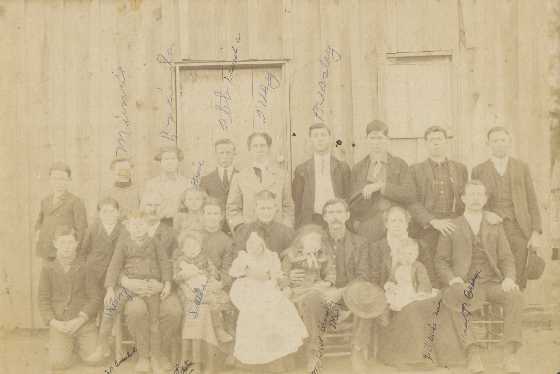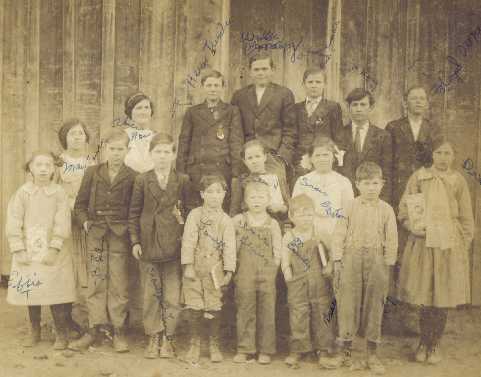
A Little Community Called Yorkburg
Written by: Peter J. Gossett
A prominent citizen of Winston County, Alabama, was a man by the name of John York. He was born January 25, 1819, in Bedford County, Tennessee, and he died April 15, 1895. John York was listed in the 1850 Hancock County Census, which means he probably lived in the area when Hancock/Winston was part of Walker County. He owned approximately 320 acres of land in the southwestern part of the county, and even though he did not own any slaves, he knew Dr. Andrew Kaeiser, who did own slaves. John York was on a committee with Dr. Kaeiser in 1861, writing to the governor of Alabama about the widespread Unionism in the area. John joined the Confederate army with the 28th Alabama Volunteers.
Whether or not the community of York was named after John York is not known. The York Post Office was established June 29, 1892, with the first postmaster being Joseph M. York; it's quite possible that this is the person the community was named after. The name of the post office changed to Yorkburg on January 20, 1894. In this same year, the post office was located very close to where the foxhunt shed is today. Actually, a map shows it to be directly across the road from the sheds. It is also not known if the post office was located anywhere else, because in those days, it usually was located wherever the postmaster lived. There were only two other postmasters for Yorkburg: James M. Romine and W. Marion O'Mary. It was discontinued on August 26, 1899, and the mail route was consolidated with Motes, which is the vicinity of the old Godfrey College south of Double Springs. It is interesting to note that a post office by the name of Natis was established within two miles of the discontinued Yorkburg Post Office, just months later and lasted until 1903 when it was discontinued and mail was sent to Motes. Natis also had a school.
Yorkburg had a school of the same name; it was a very small, one-room building and built of rough, unpainted planks of lumber. The only desks were benches made from the same type of rough lumber of the building. An exact date has not been found on when the school was established, but it was in existence in 1904. P.T. Trimble was a trustee of the school in 1911. In 1920, it was district number 51 of about 76 schools Winston County had at that time. Noah Trimble and Lois Manasco went to school here in the early 1900s, and their teachers were Mr. and Mrs. York. Lois' best friend was Rachel O'Mary, and Rachel's brother, George, would always start fights with the smaller children. Noah stated that he was taught out of the Blue Back Speller. Some of the teachers and their salaries are listed here: Helen Shumaker (1920 - $65); Irene Noblett (1920 - $60); Hearse Trimble (1922-1923); Harvey Lee Bobo (1923-1924 - $65); Fairy Harper (1925-1926); Lorus Briscoe (1929-1930 - $65); Burt Robinson (1930); Susie Henderson (1933-1934 - $72.50); and Odom Crane (1937-1938 - $55.50). In 1920, three grades were taught, and in 1922, the Winston County Board of Education allotted a $300 budget to Yorkburg School. By the time school started in 1930, the grades were taught from primer (first grade) up to the sixth grade. Another teacher included Nell Robinson (sister to Burt). Dell Bell remembers her first day of school in 1930. She had remembered how the other children told her that the teachers were mean and very strict, and she wouldn't be able to talk or play, but she says of Mr. Robinson that "he was a kind, patient man from whom I learned a lot." Dell's mother wanted to keep the school going, and as Susie Henderson and Nell Robinson did not have a place to stay during the week, she fixed up a side room and invited the teachers to live with them. The school closed on August 25, 1939, and it was consolidated with Lynn Elementary School. Natis School was consolidated with Double Springs Elementary on May 27, 1938.

In August of 1906, a church by the name of Union was constituted with 14 charter members, and it was located in the same building that Yorkburg School was in. The first deacons for Union were Francis Bell, Sylvester Alexander Trimble, and W. Marion O'Mary. It was named Union because Francis Bell was a Union soldier during the War Between the States. Francis had three brothers to die in the Union army, one in the Confederate army, and his father died while taking care of him in 1862. Actually, Francis was the only surviving male of his family that took part in the war. He was born November 18, 1842, in Marshall County, Alabama, and he died on September 4, 1925, and was buried at Union. Two early baptisms at Union Church were granddaughters of Francis Bell: Minnie Lucinda (Gann) McKleroy in October of 1908 and Martha Frances Gann on August 11, 1912.
Elder Joe Gibbs Lovelady was born on October 27, 1852, in Georgia. Elder Lovelady joined the Oak Grove Baptist Church of Christ on August 7, 1881, which was located in Black Pond. He was dismissed by letter from this church between 1890 and 1893, and in 1906, he became the first pastor at Union Church. Elder Lovelady died on October 11, 1938, and is buried at Oak Grove. Union Church joined the Clear Creek Baptist Association on September 29, 1908, at New Prospect Baptist Church in Haleyville. Messengers were Sylvester Alexander Trimble and W. Marion O'Mary, who was also clerk, and the church had 12 members.

By 1935, Union Church was inactive, and Elva Manasco asked Irving Trimble to write a letter to Jack Goswick, who lived in Texas, asking him to help, and Brother Goswick said he had been praying that God would use him, and he already had his bags packed when the letter reached him! He came to Alabama and lived with Andrew Rowe for a short period of time and became pastor at Union. At the time the "church was dead," it was being used as a barn, and old potatoes, hay, and fodder had to be cleared out before services could start. In 1940, another building was built in front of the school, and it was used for church from then on and is the present church. It had wooden shelves built on the walls between the windows for lighting. Coal oil lamps were placed on these. There was also a pot-bellied stove in the middle. It had a center aisle, and the men would sit on one side while the women would sit on the other. Vera Manasco Hogan had this to say about the church in this time frame, while in her youth: "Brother Goswick would read a scripture passage, cup a hand over his ear, and preach on and on for a very long time. I cannot remember the content of his sermons, but I can remember counting the number of times he would say 'and uh' between his sentences. This counting activity kept me awake and looking attentive on many occasions." In the mid 1940s, a revival meeting was held at Old Union, which is what the church was commonly called by this time, and it was when thirty-three people were saved.
The church land was bought from Yank and Minnie Noles for $10.00 according to the deed, but it was later found out that it sat on government property, which the church had to pay $150.00 to get the land back from the government.
The two oldest graves at Old Union Missionary Baptist Church Cemetery are two Lowrimore children: Milton L. (3/3/1873 - 7/12/1875) and Sarah E. (2/24/1869 - 8/16/1876). Most of the surnames buried here include Bell, Edwards, Gann, Harris, Hopson, Howell, McKleroy, Morris, and Noles.
Starting probably in the 1940s a few miles northeast of the Yorkburg School and Union Church were the foxhunts. Two sheds were built on the west side of the road, while a concession stand was made out of an old building on the east side of the road. This small building, which had a counter in it with shelves behind it, a rock doorstep, and a small top over the front door, was most likely the old Yorkburg Post Office. Hunters would gather, not only from Winston County, but from many miles around. The conventions would be held all weekend long with box plates being sold for supper. Contests were held for the dogs, and a place was fixed for bands to play gospel and old-time music. Nighttime was used for hunting. These conventions stopped sometime in the early 1960s, and one of the sheds was torn down in the late 1980s. Picnics and reunions were still held in the other shed, which had tables, a barbecue pit, and an outhouse. Hurricane Katrina, in 2005, heavily damaged the remaining shed beyond repair. On July 30, 2005, a grave ceremony was held at Old Union Cemetery for Union soldier Francis Bell; it included a twenty-one gun salute by First Alabama Cavalry reenactors. Old Union celebrated its 100th year on September 10, 2006, and throughout 2008 and 2009, a new church building was being built which was dedicated on December 6, 2009. The groundbreaking for the new church was held on August 24, 2008.
Pastors of Old Union:|
Pastor |
Years |
|
Joe G. Lovelady |
1906 – 1909 |
|
D.S. Smith |
1909 – 1910 |
|
No Pastor |
1910 – 1912 |
|
J.J. Bartlett |
1912 – 1915 |
|
No Pastor |
1915 – 1916 |
|
J.J. Bartlett |
1916 – 1918 |
|
No Pastor |
1918 – 1919 |
|
J.C. Steele |
1919 – 1920 |
|
A. Dickinson |
1921 – 1923 |
|
Ben Dodd |
1923 – 1924 |
|
W.T. Whitfield |
1924 – 1925 |
|
No Pastor |
1925 – 1927 |
|
No Records |
1927 – 1935 |
|
Jack Goswick |
1935 – 1944 |
|
Clyde Latham |
1944 – 1946 |
|
Fred Kitchens |
1946 – 1947 |
|
Herbert McCauley |
1947 – 1948 |
|
Claude McClendon |
1948 – 1952 |
|
J.W. Northcutt |
1952 – 1953 |
|
Ebb McClendon |
1953 – 1955 |
|
Brother Mims/No Pastor |
1955 – 1956 |
|
Mark Thomas |
1956 – 1958 |
|
Ebb McClendon |
1958 – 1983 |
|
Kenneth Sudduth |
December 6, 1983 – December 2009 |

Old Union Baptist Church, 1944
Sources:
1850 Hancock County Census
1860 Winston County Census
Record of Appointment of Postmasters
1867 Voter Registration and Loyalty Oaths
Winston County Board of Education
History of the Clear Creek Baptist Association by Jerry Burns
"History of Old Union Missionary Baptist Church" by Louise McKleroy
Cemeteries of Winston County, Alabama by Ruth Ferguson
Old Union Church Books
Letter from Dell Bell to Louise McKleroy, March 30, 2006
"Memories of Old Union Baptist Church" by Vera Manasco Hogan
Judy & Perlean Gossett Interview, April 13, 2006
"Life of Noah and Lois Trimble" by Louise McKleroy
Telephone conversation with Linward Wideman, April 13, 2006
Pictures courtesy of Louise McKleroy